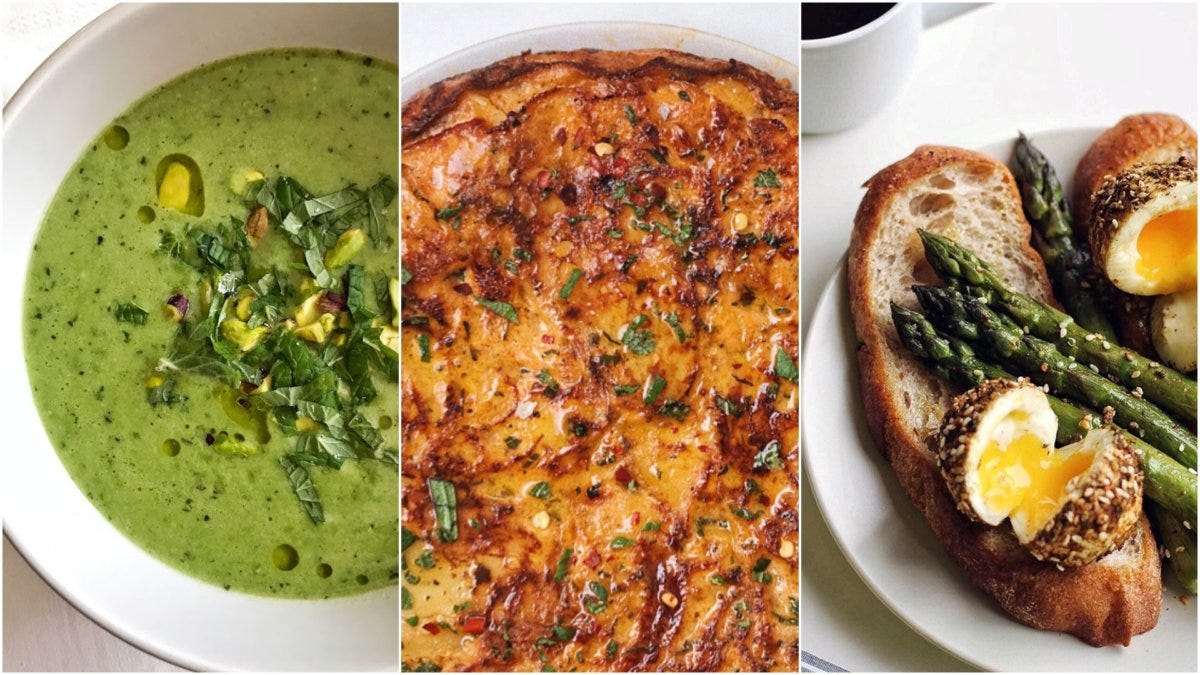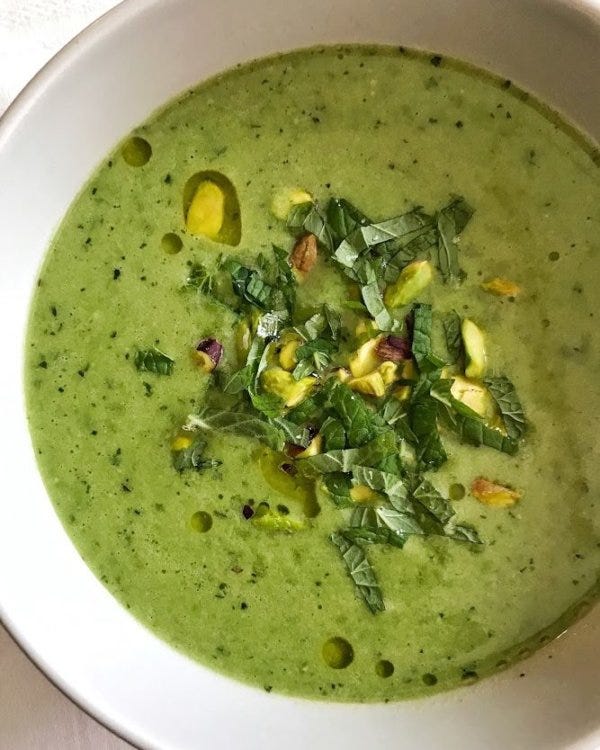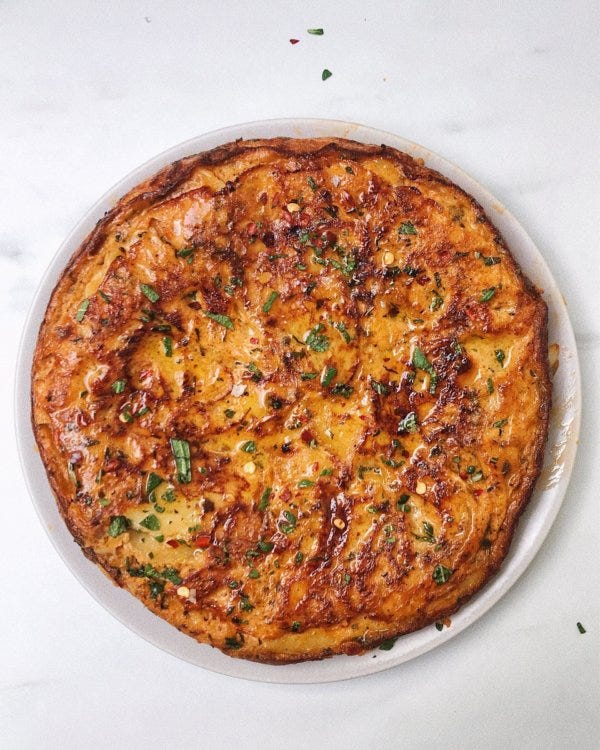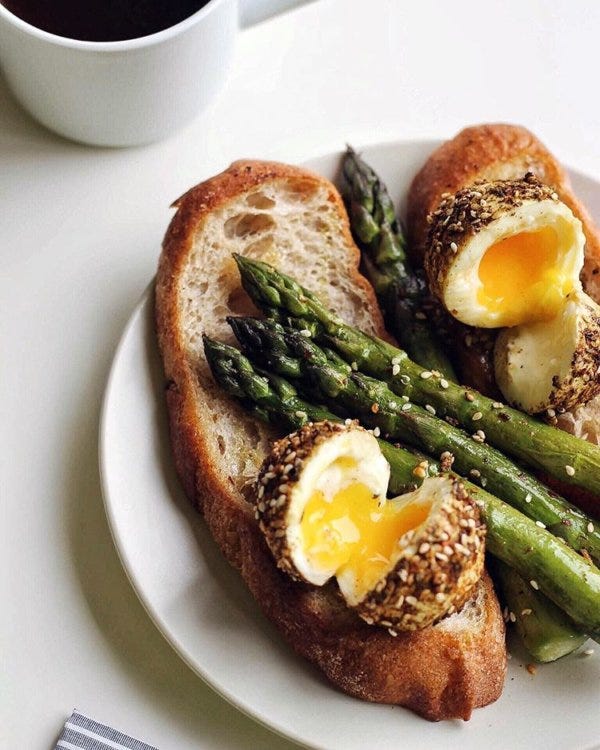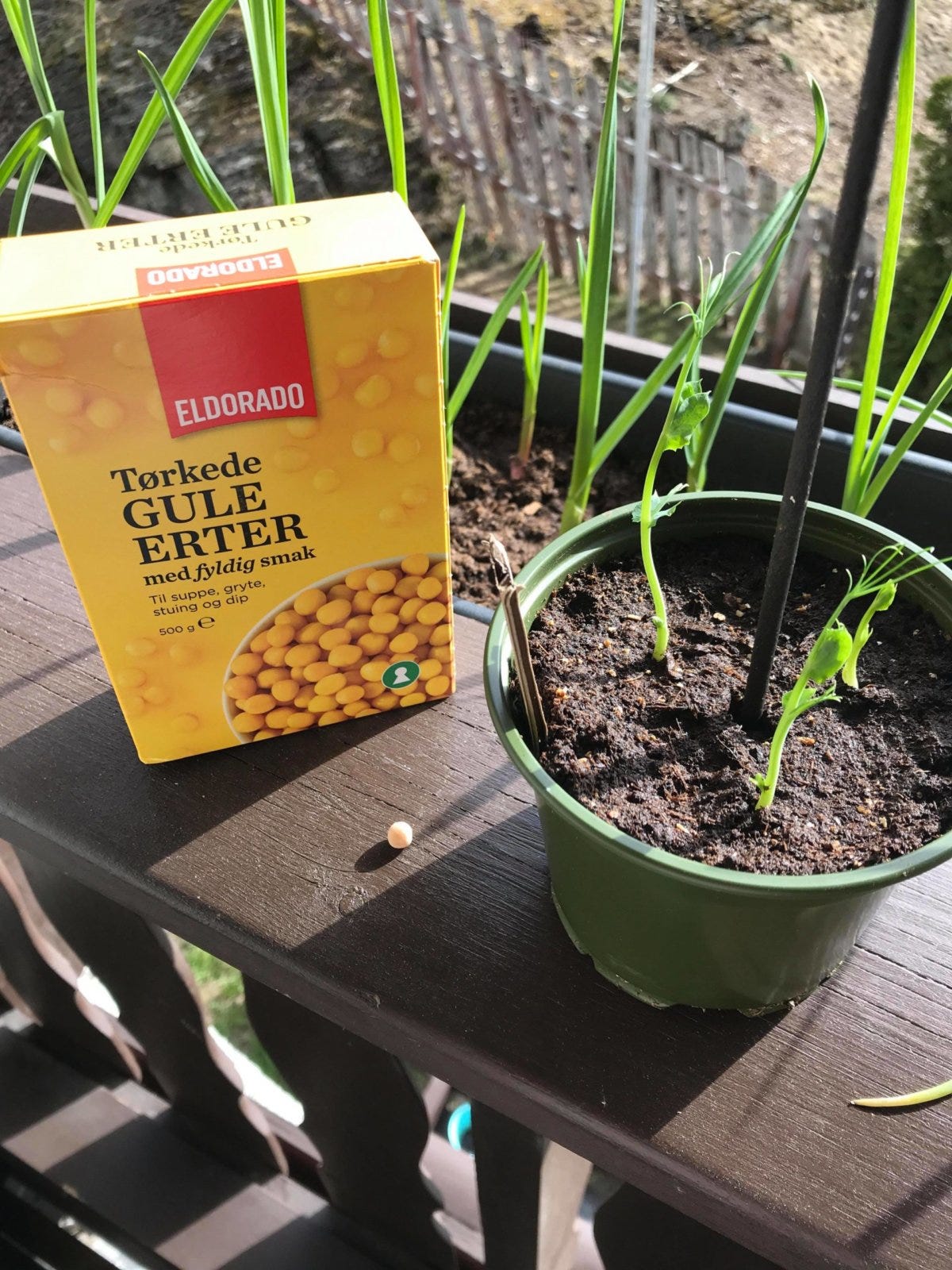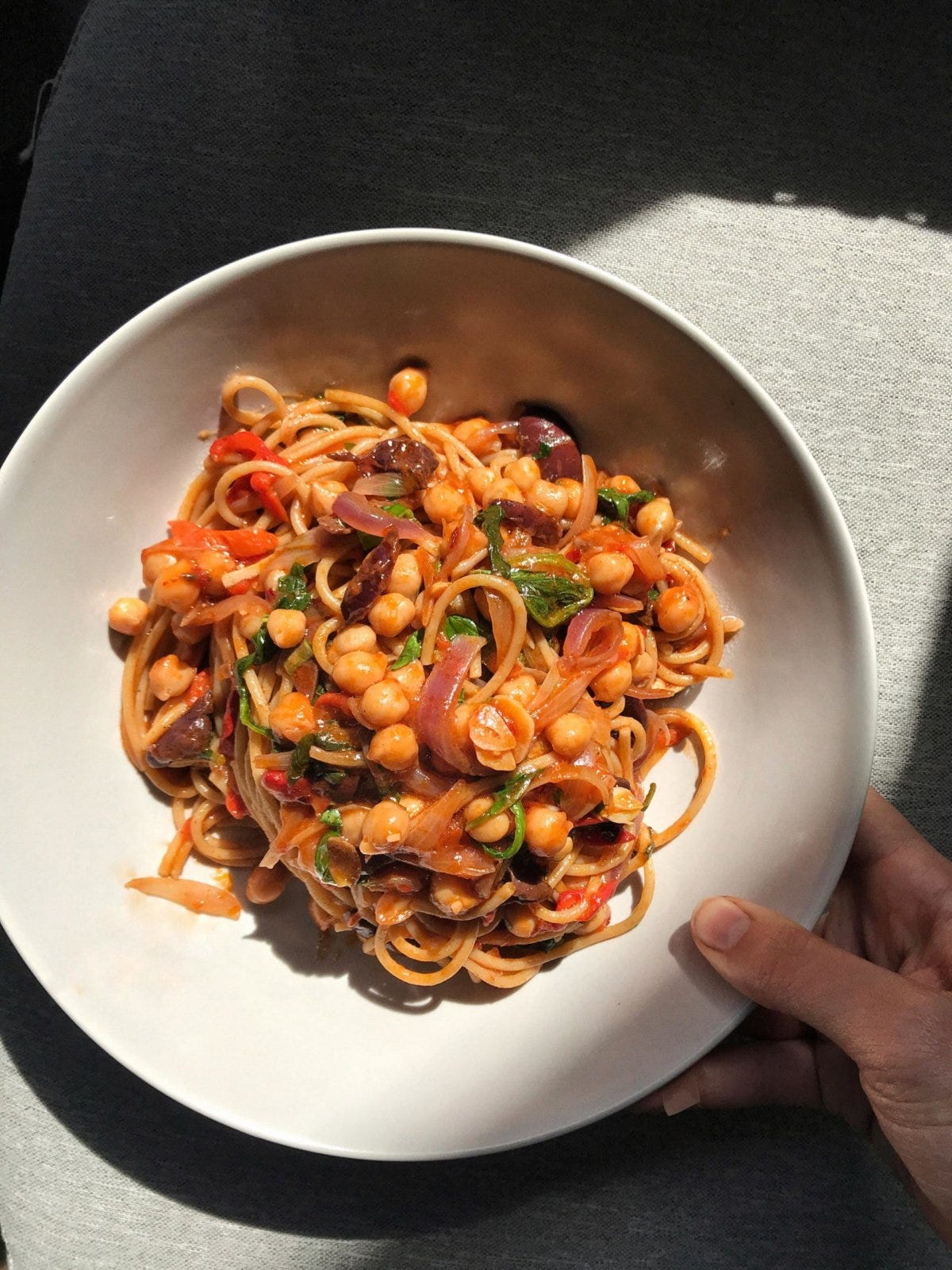Flaky Spring Tart & A Savoury Pantry Pasta
plus, how to get more out of the grocery store ✨
Allô! 👋
You were warned that this is a monthly-ish newsletter, so I suppose it's no big surprise that there was none last month. And if you follow me on Instagram you know that March was rather busy with a big move and two different renovation projects (we moved out of the city and into a house! we ripped up the old floors and put in new ones! we built a kitchen!) so it feels good to be back.
This month I've probably spent about the same amount of time gardening as I have cooking, and while I often don't listen to anything while I cook I do enjoy listening to music or a podcast while I'm filling pots and sowing seeds. Below I share a few playlists that I've been enjoying + a seriously interesting podcast episode that covers very important topics surrounding food.
Speaking of sowing seeds, I've been getting a real thrill from the seedlings that have grown out of things I bought at the grocery store (more on that later). I can hardly imagine how excited I'll be when I can start growing from seeds we've saved from our own home-grown produce!! Let alone how exciting it'll be to walk out into the yard, “shop” around for the freshest of ingredients, then turn them into something delicious all within a very short span of time.
And on that note, let the cooking begin! This newsletter starts with a recipe for a deceptively simple flaky spring tart, after which I tell you how to pull together a delectable pantry pasta that'll make you forget that very few vegetables are actually in season during this time of year*.
Wishing you good food, good mood, and a sense of all being renewed (it is spring after all),
👋simone
*what I'm referring to here is called “the hungry gap”, and you can find a nice little overview of what the phenomenon is right here
recipe for a light & flaky spring tart 🌷
I love all the spring tart recipes that pop up this time of year, ushering away all the heavier menu items that came before them in winter and fall. Trouble is, most of them include cheese. And I hate cheesy tarts.
Now, as a general rule, I don't mind cheese (well, at least not the mild ones like young cheddar and mozzarella, or good Parmesan). But I must admit being one of those people who could easily live without the stuff.
So one day where a flaky spring tart seemed to me the only appropriate thing to eat, I improvised this one. It was so good that's I've been making it on an annual basis ever since.
•••
a flaky allium and new potato tart with sesame-sprinkled pastry
serves 3
INGREDIENTS
• 3 pre-made puff pastry sheets (you can of course make your own pastry, but this is a relatively quick recipe), 1 per tart
• 2 large onions
• 6-8 shallots
• 2 large bay leaves
• 1 leek
• 8 garlic cloves, or about half a bulb
• enough green onions to have 6 shoots (the green tops)
• a kettle-full with approx. 500 mL of just-boiled water, or approx. 500 mL of vegetable stock*
• 1-2 tsp stock powder or 1/2 a bouillon cube*
• 2 small oblong potatoes, or 3-4 small round ones
• 1 Tbsp fresh thyme, plus more for garnish
• 1 tsp dried herbes de Provence or similar herb blend, plus more for finishing
• sesame seeds
• olive oil
• salt
• pepper
*for reference, I used a combination of water from the kettle and stock powder, but if you are using liquid vegetable stock instead, just add it in whenever the recipe calls for water and ignore the part when it calls for the stock powder / bouillon cube
PREPARATION
1. Remove your pastry sheets from the freezer and place them on a baking tray lined with parchment paper to thaw.
2. Peel and thinly slice your onions from root to shoot, then place them in a large pan on medium-low heat with a glug of olive oil and a small pinch of salt. We just want them to soften and sweeten, not fry, so gently stir in a splash of water from your kettle any time you hear them begin to sizzle, if you see them start to colour, or if some of them begin to catch on the bottom of the pan.
3. In the meantime, peel and quarter your shallots lengthwise. Add them to the pan with the bay leaves, giving everything a little stir and topping up with a splash more of water if necessary.
4. Peel the garlic cloves and clean the leek well. Keep the garlic cloves whole, and cut the leek across its width into thin slices. Add the garlic and the white part of the leek to the pan, reserving the leek greens for later. If using the whites of your green onions, thinly slice them now and add them in at this step (I keep my green onions in water so I can re-grow them, hence do not use the whites). Let cook for 3-4 minutes, stirring occasionally and adding more water again if the bottom of the pan gets dry.
5. Add the stock powder or bouillon cube, fresh thyme, dried herbs, a bit of salt and pepper, and the green part of the leek. Stir again to combine. Top up with enough water to generously cover the bottom of the pan, then turn the heat up to medium-high so the liquid can evaporate and the alliums can finish softening through.
6. While the alliums finish cooking, slice your cleaned potatoes lengthwise as thinly as you can.
7. Once the alliums are done, fish out the bay leaves. Then, remove 1/3 of the alliums from the pan and blitz into a purée with the help of an immersion blender.
8. With a sharp knife, draw a border (about as wide as the tip of your thumb) parallel to the edges of each pastry sheet. You want to lightly pierce the top layer without cutting through the pastry entirely. Then, prick all over the middle portion of each pastry sheet with a fork. This will prevent the centre from rising during baking, all while the outer frame is free to puff up.
9. Avoiding the outer frame, spread even amounts of the allium purée onto each pastry sheet. Then layer on the sliced potatoes, overlapping them slightly, and cover with any leftover purée. Finish by topping the tarts with the unpuréed alliums from the pan, followed by two green onion tops each.
10. Brush the pastry edges with water and sprinkle on enough sesame seeds to cover. Add a bit more fresh thyme and a faint drizzle of olive oil all over the tarts.
11. Bake in the middle of the oven at 200°C fan / 220°C / 430°F until the edges have puffed up and are golden, around 20 minutes or so (check the package your pastry came in or the pastry recipe you followed).
12. Remove from the oven, sprinkle with a smidge more herbs (fresh and/or dried, you decide) and some flaky sea salt. Enjoy!
it's mid-spring: what to cook? 🌼
Recipes from the site to help make the most of this revitalising time of year.
cool pea soup
Topped with crushed pistachios, fresh mint, and a drizzle of extra virgin olive oil, this effortless and luxurious pea soup is bound to leave you feeling satisfied.
tortilla de patatas with gochujang & woody herbs
A Spanish classic with an unexpected twist makes for an explosion of flavour that's bound to have you coming back again and again.
asparagus & spiced egg on toast
Start your day with a breakfast that's bound to put a smile on your face. Fresh asparagus, bread & eggs (+a few pantry staples) are all you need.
food for free! 💰
getting more out of the grocery store
Three little pea shoots growing from dried yellow peas, ten days after being planted.
It's interesting how easy it can be to overlook the fact that supermarkets sell seeds. While some stores actually do carry ready-to-plant gardening packets, that's just one small piece of the picture. What I'm referring to here is simply the whole foods they sell – which despite being full of seeds (like bell peppers and melons) or actually being a seed (like quinoa and peas), are rarely ever thought as such.
Now, before you start planting every seed, bulb and tuber you bring home from the grocery store, I should tell you that planting seeds from store-bought ingredients is not guaranteed to help you stretch out your food dollars (or whatever your local currency may be).
Some things like planting popcorn kernels or sprouting potatoes should work in theory, however the corn used in popcorn kernels doesn't taste all that great fresh and the potatoes from the grocery store are often prone to disease. And that's if you even get them to grow in the first place.
Having said that, some things are certainly worth the shot if you've got room to grow a plant or two.
One of the earliest vegetables you can sow – that also happen to be relatively easy to grow – are peas. They also grow incredibly quickly (especially if you're simply looking to harvest tendrils and shoots). You might be surprised to find that the dried peas in your cupboard can be planted! All you have to do is soak them for 24 hours first. At worst, nothing grows. At best, you just got more food out of your food!
Another great thing to plant is garlic (can you spot it behind the peas above?). One clove has the potential give you a whole new bulb, and even the young green leaves and curly scapes they shoot up are absolutely delicious.
Speaking of aromatics, dill, fennel and coriander seeds from the spice aisle can all be planted and will sprout if not too old. Grains like quinoa and whole wheat or barley can be planted too, as well as dried beans and legumes (I've got some lentils and quinoa growing on my windowsill as I type).
While certainly no expert on the matter, my advice when it comes to growing from grocery stores would be to plant from things you would have bought anyway - that way you can treat the experience as a fun experiment and not get too disappointed if things don't work out.
How's that for a fun spring activity?
If, however, all you're looking for are reliable seeds and a more diverse range of plant varieties, then the garden centre is still the place to go. There's no shame in trying both ways, though, and that's exactly what I'll be doing.
recipe for a savoury pantry pasta 🍝
This dish started as an “uh oh, it's almost lunch time and I have no idea what to make” meal, and turned into something truly spectacular.
Made with nothing but pantry (and freezer) items, this is a perfect dish to enjoy before a big grocery shop – or simply to savour on a bright or grey mid-spring's day when barely a thing is actually in season.
Also, something about the fact that it has both greens and beans in it makes it (to me, at least) extra satisfying.
•••
a seriously savoury & saucy pantry pasta
serves 3
INGREDIENTS
• 1 red onion
• 4-6 shallots (depending on size)
• a dozen kalamata olives, pits removed
• 2 grilled marinated peppers
• 6 garlic cloves
• 1 tsp red chili flakes
• 6 - 8 Tbsp tomato paste
• 1 heaped tsp of any red pepper paste you have on hand (I used gochujang)
• 1 can or box cooked chickpeas, with their cooking liquid
• whole wheat spaghetti, however much you think is enough for 3
• 3-5 generous handfuls of spinach leaves, frozen* or fresh (more handfuls if frozen, less if fresh)
• fresh parsley
• fresh basil
• green onions
• olive oil
• salt
• pepper
*for reference, I buy bags of fresh spinach from the salad aisle and pop them straight into my freezer – pucks of chopped spinach from the frozen aisle are a whole other beast and likely would not work well in this recipe
PREPARATION
1. Peel and thinly slice your onion and shallots. In a large heavy pan at medium-high heat, pour in enough olive oil to generously cover the bottom of the pan. Add in your sliced onion and shallots, and let cook, stirring occasionally, until the onion and shallots have softened and caramelized slightly. This should take about 15-20 minutes.
2. While the onion and shallots are still cooking, slice your olives and roasted peppers and add them to the pan.
3. Still while the onion and shallots are cooking, peel and thinly slice your garlic cloves. Add them to the pan with some salt, pepper and the chili flakes.
4. By now the the onion and shallots have almost completely softened. Add in the first 6 Tbsp of tomato paste, plus the red chili paste and stir them through. Add another generous glug of olive oil, plus all the chickpeas and their cooking liquid. Season again with salt and pepper. You want your sauce to become glossy as the olives and peppers melt into the onions and shallots and take on the tomato paste's rich colour and aroma.
5. Put a large pot of water to boil and season it very generously with salt. As the sauce continues cooking and the chickpea liquid evaporates, cook the pasta for 7-8 minutes.
6. Once the spaghetti is cooked, transfer the noodles directly from the pot to the sauce pan. Add some of the pasta cooking water to the sauce, one small ladle at a time, swirling it in and letting it absorb in between additions, and stopping once it looks like the sauce could absorb no more (this probably ends up being about 250mL pasta water in total).
7. Wilt in the spinach, stirring it through the noodles. Turn off the heat. Roughly chop the parsley, basil and green onions and stir them through, along with a final seasoning of flaky salt, freshly cracked black pepper and chili flakes, plus a final quick glug of extra virgin olive oil.
8. Serve hot (and try not to be so distracted by the incredible flavour that you accidentally get sauce on your shirt; I got sauce on my shirt).
Note: you could likely eat the “sauce” with a different grain, or even spread it thickly onto toast or a wedge of pita bread. It is so good I almost feel it deserves to be more than just spaghetti sauce!
the final note 🎵
First, this podcast episode is a must-listen for anyone who eats food.
Second, these playlists (made by moi) have brought me a fair bit of joy over the last month or two. Maybe they'll do the same for you!
classic cosy — the perfect backdrop to any cosy activity
mood for food — catchy old tunes with food-related titles
60s french — a tasteful list of french hits that'll transport you right to les années 1960
surprise swedish — songs you've probably heard but never guessed were by Swedish artists
Happy cooking, gardening and listening!
See you in the next newsletter ♥
This was a Substack edit of an archived newsletter. To read the newsletter in its original format, click here.




